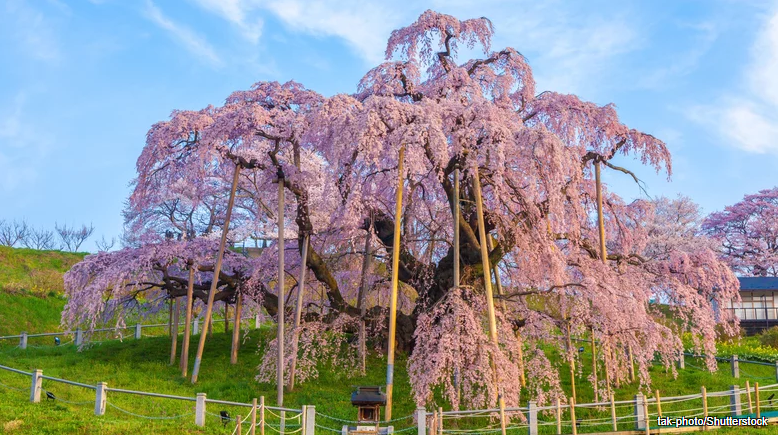
The Weeping Cherry Tree (Prunus x subhirtella), is a small deciduous flowering tree. It is ornamental tree in nature and is appreciated by many gardeners for its cascading branches and stunning blossoms. It is a hybrid between Prunus itosakura and Prunus incisa. It is a member of the Rosaceae family, which also includes other flowering plants like roses, apples, and peaches.
The weeping cherry tree is believed to have originated in China and was later cultivated in Japan in the 8th century as an ornamental tree for the homes of royalty in Kyoto. It quickly gained popularity and replaced the plum tree as a favorite in Japan. After World War II, the Japanese government donated thousands of cherry trees to the United States as a gesture of friendship, and these trees are now grown in most parts of the country, especially in warmer states.
These trees are popular for their drooping or “weeping” branches that create a dramatic, umbrella-like shape. The branches are covered in small, delicate flowers in the spring, which can range in color from white to pink. The flowers are followed by small, inedible fruits that attract birds. The leaves of the weeping cherry tree are 2-5 inches long and have a serrated edge, turning yellow in the fall before dropping for the winter.
There are several varieties of weeping cherry trees, including dwarf and full-sized options. Dwarf varieties can grow to be 6-15 feet tall and 2-15 feet wide. Full-sized trees can grow up to 30 feet tall with a similar spread. They grow at a moderate rate of 1 to 2 feet per year. These trees are not grown for their fruit, as it is generally considered inedible due to its small size and sour taste.
These trees are hardy in USDA Zones 5 through 8, which means they can tolerate a range of temperatures, from cold winters to hot summers. They prefer full sun to partial shade and well-drained soils. Other than weeping cherry tree, other names for this tree include: winter-flowering cherry, spring cherry, or rosebud cherry.
Characteristics of Weeping Cherry Tree (Prunus x subhirtella)
- Size: Can grow to a height of 20-30 feet with a similar spread. Dwarf varieties are available, with a maximum height of 6 feet tall and wide.
- Growth Habit: The branches grow upwards from the trunk and then arch downwards, creating a cascading effect.
- Growth Rate: They grow 1 to 2 feet per year under optimal conditions.
- Root System: Healthy trees have fibrous root system that spreads laterally near the surface of the soil.
- Leaves: The leaves of a weeping cherry tree are 2-5 inches long with a serrated edge. They turn yellow in the fall before dropping for the winter.
- Bark: The bark is not specifically mentioned, but it is likely similar to other cherry trees, with a smooth texture that may become rough and fissured with age.
- Flowers: The trees are valued for their flowers, which bloom in the spring. They produce single or double pink flowers, depending on the variety.
- Lifespan: Trees have a lifespan of 25 to 50 years.
- USDA Zones: Trees are hardy in USDA zones 5 through 8.
- Sun Requirements: They prefer full sun but can tolerate partial shade.
- Soil: They require well-drained soils and are not tolerant of wet or poorly drained conditions.
- Water Requirements: Young trees need regular watering, especially when first planted, to establish the root ball. Mature trees are more drought tolerant but still benefit from regular watering.
- Pruning: Pruning is essential for maintaining the tree’s shape and promoting healthy growth. It is best done in the late winter or early spring.
- Diseases and Pests: They are susceptible to pests such as spider mites, Japanese beetles, and diseases like root rot, cherry leaf spot, and powdery mildew.
Weeping Cherry Tree Problems (Diseases and Pests)
Diseases
- Verticillium Wilt: This is caused by a soil fungus called “Verticillium dahliae” or “Verticillium albo-atrum.” It enters the tree through the roots and spreads throughout, causing wilting and yellowing of leaves.
- Cherry Leaf Spot: Caused by the fungi “Blumeriella jaapii,” this disease is common during the summer season, resulting in spots on leaves, which can turn purple or red.
- Powdery Mildew: This fungal disease appears as deposits of fine white powder on the leaves, stems, or twigs of the tree. Leaves may drop prematurely.
- Canker Diseases: Cankers are dead areas of bark that can girdle branches, leading to dieback and decline of the tree. They are caused by various fungal pathogens.
- Black Knot: Black knot is a fungal disease that appears as black swellings or knots on branches. It can lead to branch dieback if not managed.
Pests
- Aphids: These are small, soft-bodied insects that can cause damage by sucking sap from the leaves and stems of weeping cherry trees. They can also spread diseases from plant to plant.
- Spider Mites: These are tiny arachnids that feed on the sap of leaves, causing yellow or brown spots and potentially significant damage to the tree.
- Canker Diseases: Cankers are areas of dead bark that can girdle branches, leading to dieback and decline of the tree. They are caused by various fungal pathogens.
- Powdery Mildew: This fungal disease appears as deposits of fine white powder on the leaves, stems, or twigs of the tree. Leaves may drop prematurely.
- Cherry Leaf Spot: Caused by the fungi “Blumeriella jaapii,” this disease is common during the summer season, resulting in spots on leaves, which can turn purple or red.